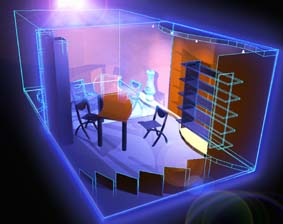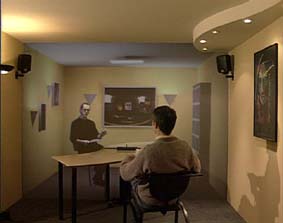TELEPORT - A 3D Telepresence System
by Christian Breiteneder
The TELEPORT environment is designed to overcome disadvantages of desktop videoconferencing and to establish life-like conference sessions that bring people together as if face-to-face. The system consists of a real room with one wall entirely covered b a display surface. Onto that surface a virtual extension of the real room is projected. As the local participant moves, his location is tracked thus allowing the synthetic scene to be rendered with the correct perspective.
The main goals of TELEPORT are:
- to demonstrate the use of wall-sized displays integrated in a working or living environment
- to demonstrate an immersive teleconferencing environment without the need for head-mounted displays
- to analyse, test and validate user requirements in diverse areas, such as tele-teaching, tele-music and tele-architecture design.
The innovative features of TELEPORT include:
- merging of real and virtual environments
- viewer tracking and real-time rendering
- an image segmentation system capable of extracting participants from a controlled background
- compositing of live video with synthetic backgrounds.
The TELEPORT display shows a synthetic 3D scene into which the video images of remote participants are blended. Other virtual reality systems, notably the CAVE (CAVE Automatic Virtual Environment) have also experimented with wall-sized displays. However the unique feature of TELEPORT is that the display is built into a real room carefully designed to match the rendered scene in colour, lighting and general appearance. Room borders, walls and the ceiling are aligned to the real walls and ceiling surfaces. The intention is for the virtual room to appear as an extension of the real room. This feature, combined with head tracking and possible stereoscopic display, give the impression of a single, continuous, space.

Figure 1: The TELEPORT environment as designed and implemented: one
entire wall of the room is equipped with a display surface serving as a
window into a virtual extention of that room.

Figure 2: The virtual extention is carefully designed to match the real
room to which it is attached.
Applications
TELEPORT is certainly not intended to replace face-to-face meetings, but to offer an alternative when such meetings are difficult or impractical. Scenarios where TELEPORT could be used include:
- Cooperative 3D work - designers, architects or engineers could use TELEPORT for distributed manipulation and visualization of 3D objects, as for example in shared CAD applications.
- Distributed negotiation - sensitive negotiations and conflict resolution meetings are best held face-to-face. The telephone or traditional forms of video conferencing fail to convey body language and other subtle channels. When it is simply not possible to gather participants in a single place, TELEPORT may be an appealing alternative:
- the physically disabled - for such people TELEPORT offers a means of surrogate travel, a natural way of communicating with other people despite being in different places
- education and remote consultation - teachers or professors could meet directly with students located in other cities or countries. Similarly, lawyers and other professionals could meet with remote clients.
Technical Realization
TELEPORT runs on two multi-processor SGI Onyx with RE2s. One machine renders the virtual room in real time, the second machine runs a parallel delta-keying algorithm which separates the remote participant from the original background. For testing purposes the remote participant may be placed in a blue room in which case separation is performed using an Ultimatte System 7.
In either case, separation produces a 4:2:2:4 signal which is rendered as a transparent video texture with the aid of a Sirius board. The position of the local participant is measured by an optical tracking system (3rdEye from DynaSight). More information on the World Wide Web at: http://viswiz.gmd.de
Please contact:
Vali Lalioti - GMD
Tel: +49 2241 14 2787
E-mail: vali.lalioti@gmd.de
Martin Göbel - GMD
Tel: +49 2241 14 2367
E-mail: martin.goebel@gmd.de
